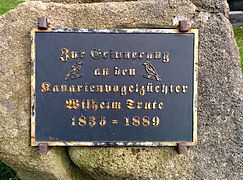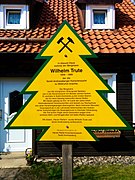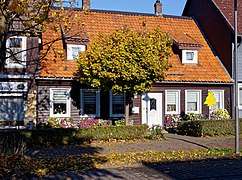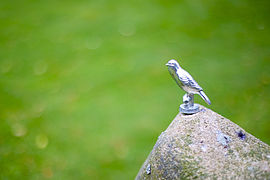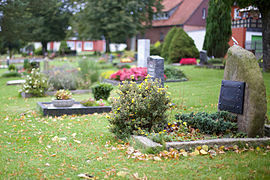Wilhelm Trute
Heinrich Friedrich Trute , called Wilhelm Trute (* March 5, 1836 in Sankt Andreasberg ; † October 20, 1889 ibid, in the older spelling Truthe ) was a Harz miner and breeder of singing canaries , the " Harz Rollers ".
Life
Wilhelm Trute was born in Sankt Andreasberg in 1836 as the only child of Georg Conrad Trute and Johanna Henriette Trute (née Keitel). Little is known about Trute's childhood and youth. Presumably he attended as all Andreas Berger children to school in the village and worked in his youth as Pochknabe in Andreas Berger Erzwäsche to introduce a supplementary earnings in the budget.
He took up his father's profession and became a miner. As such he worked first in Clausthal , later in the royal Samson silver mine in Sankt Andreasberg.
With his wife Henriette Minna Charlotte Trute (née Gödecke) he had an only son, Carl Trute.
Trute practiced his profession and his passion - breeding canaries - until his rheumatism and, from 1889, a stomach ailment that turned out to be stomach cancer, tied him to the bed. After a long suffering, he died on October 20, 1889 at 12:45 p.m.
Canary breeding
Wilhelm Trute's ancestors came from the Erzgebirge to the Harz Mountains as early as the 15th century, which makes Trute's family one of the oldest in Sankt Andreasberg. It is not known since when his ancestors started breeding canaries. Like other Andreasbergers at that time, his father already bred landrace canaries - the so-called Japper.
"Around 1865 Wilhelm [Trute] received two high-quality singers from the silver smelter Wilhelm Weiland, who was related to Trute." ( Gottfried Drott : Die Trut'sche Legende ). It can be assumed that the first Harzer Roller emerged from this crossing. Unlike the yellow birds known today, these rollers from the "Trutschen Tribe" had gray to gray-green plumage and were already characterized by their particularly good hollow and ping-roll singing . They made his breeder and his hometown famous around the world.
Unlike other breeders, Trute only used birds from this one strain for breeding. He was also reluctant to sell the animals by mail order. Dealers and end users had to pick them up from the grower in Andreasberg.
Trute bred the popular birds in his house at Schützenstrasse No. 90 (today No. 40) until his illness tied him to bed in 1889 and made breeding impossible for him.
Awards
In honor of Trute's successes in canary breeding, an oversized, stylized Harz farmer ( location ) was dedicated to him in a commemoration ceremony on May 2, 1999 in his home town . To symbolize the special relationship between mining and canary breeding , a desilvering kettle was installed in the cage instead of the bird bowl. In 2001 a Dennert fir tree ( location ) was added to the memorial to commemorate the breeder's success. Another Dennert fir tree with information about the breeder is located at his former home ( location ).
Wilhelm Trute monument in Sankt Andreasberg
Dennert-Tanne at the Wilhelm-Trute-Monument
Transport bird farmer for canaries, as used in the 18th and 19th centuries for the Harz scooters for shipping all over the world.
The Förderverein Friedhof Sankt Andreasberg eV has rebuilt his grave ( location ) in cooperation with the mining museum Grube Samson at its original location on the Andreasberg cemetery in memory of the breeder . To underline Trute's achievements in canary breeding, a silver canary was placed on the tombstone. The grave has been tended by the association since the restoration.
Harzer Roller on Wilhelm Trute's grave
Wilhelm Trute's grave in Sankt Andreasberg
Web links
Individual evidence
- ^ Wilhelm Trute's death certificate
- ↑ a b c Jochen Klähn: Comments on the canary bird . from the Harz Roller Canary Museum in Sankt Andreasberg. Ed .: Andreas Klähn. 1st edition. Sankt Andreasberg 2006, p. 6-9 .
- ↑ a b Gottfried Drott: The Trut'sche Legende. In: The bird friend. Edition 10/98, p. 13.
- ↑ Monument inaugurated in honor of the canary breeder Wilhelm Trute . In: Goslarsche Zeitung . May 2, 1999 ( online in the archive).
- ↑ A new information board for the Trute memorial was set up . In: Goslarsche Zeitung . January 2, 2001 ( online in the archive).
| personal data | |
|---|---|
| SURNAME | Trute, Wilhelm |
| BRIEF DESCRIPTION | Harz miner and breeder of singing canaries |
| DATE OF BIRTH | March 5, 1836 |
| PLACE OF BIRTH | Sankt Andreasberg |
| DATE OF DEATH | October 20, 1889 |
| Place of death | Sankt Andreasberg |


